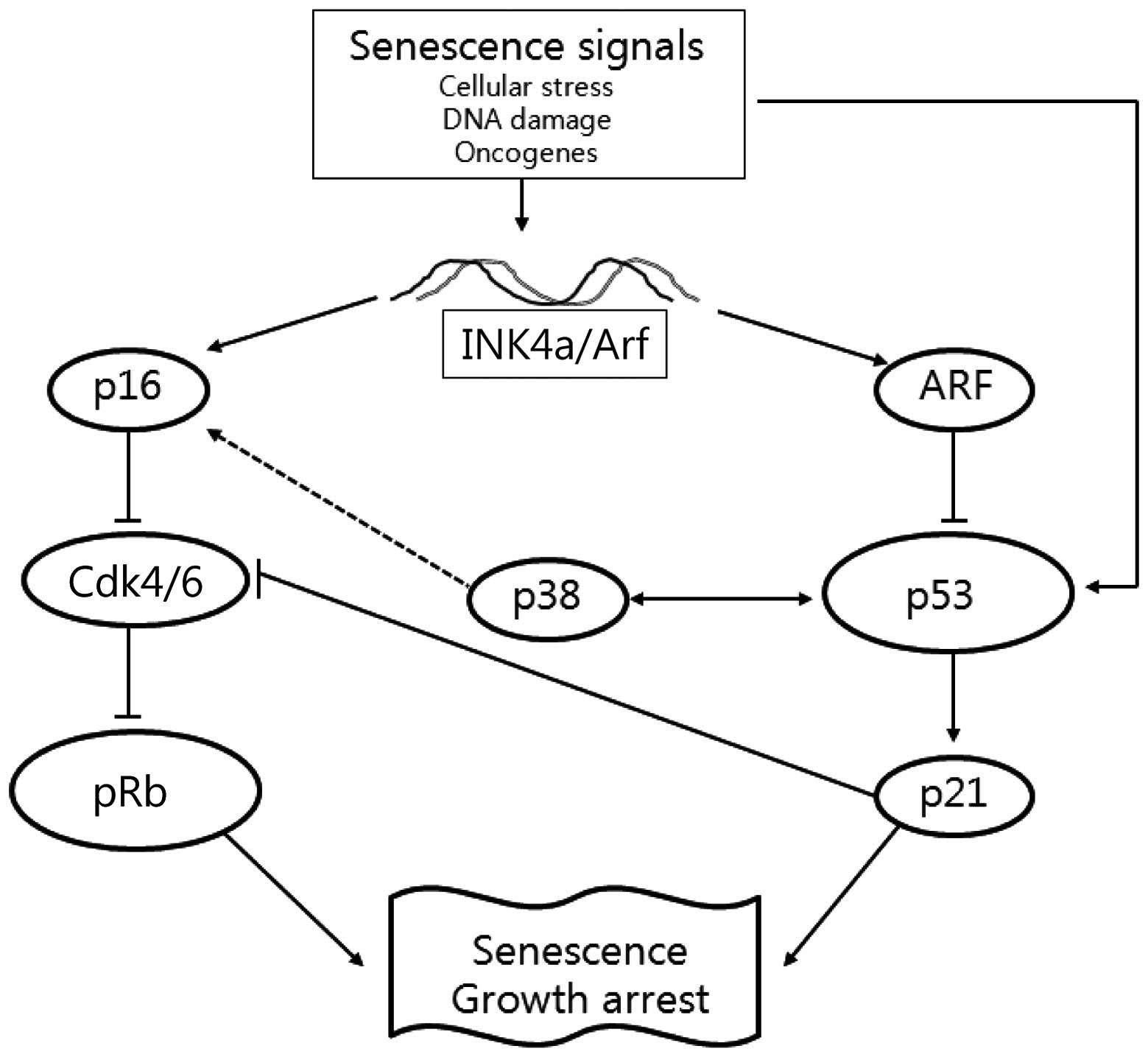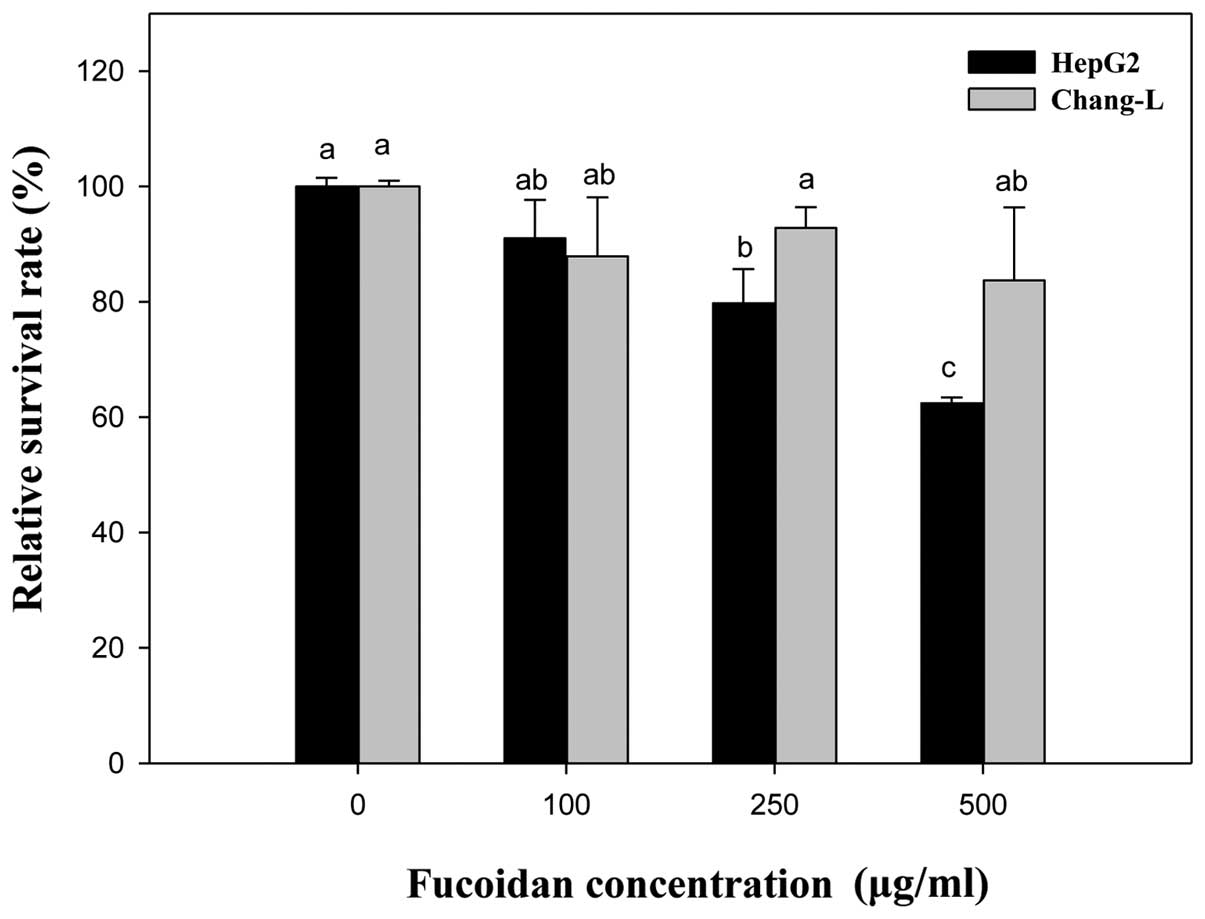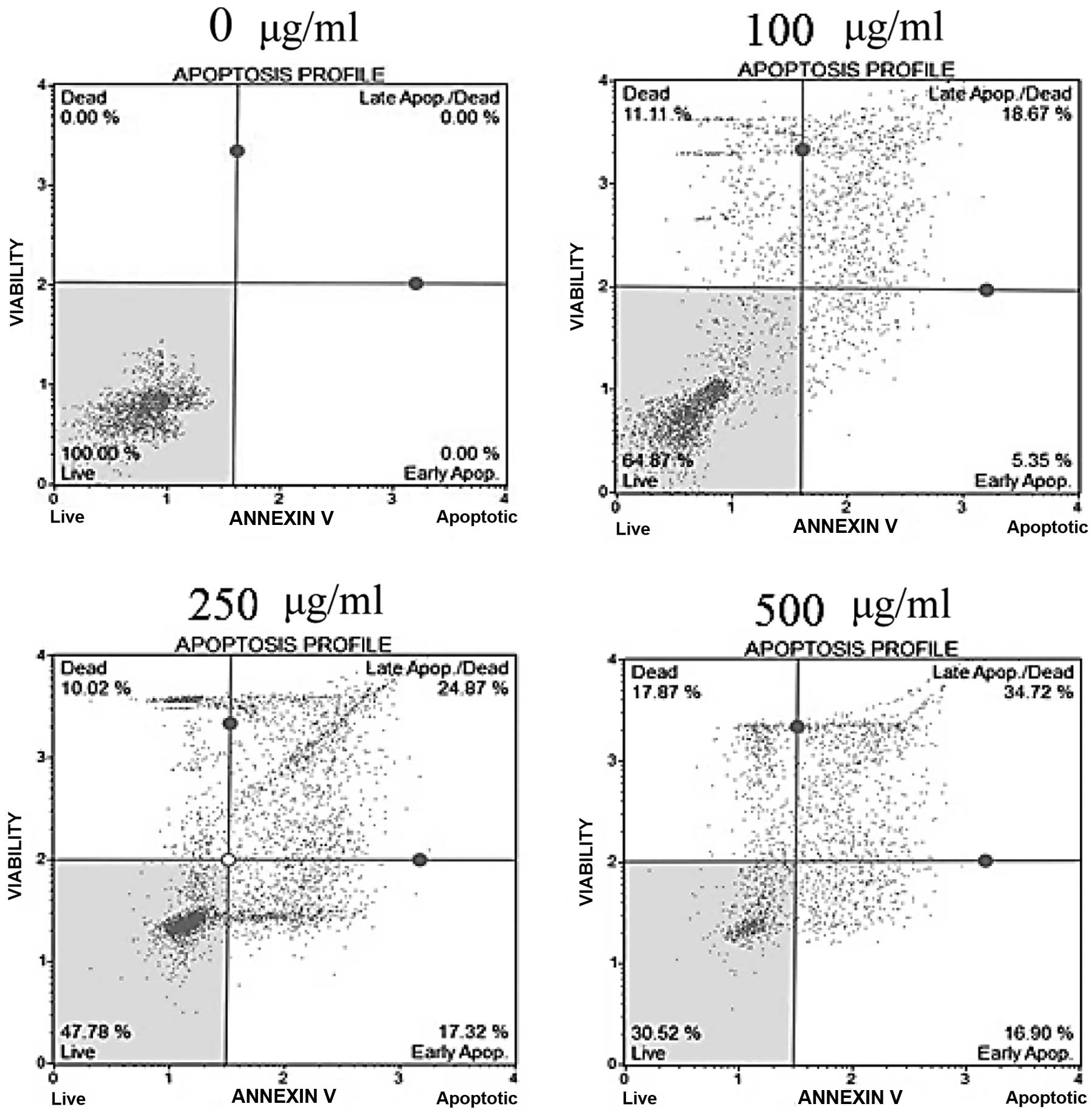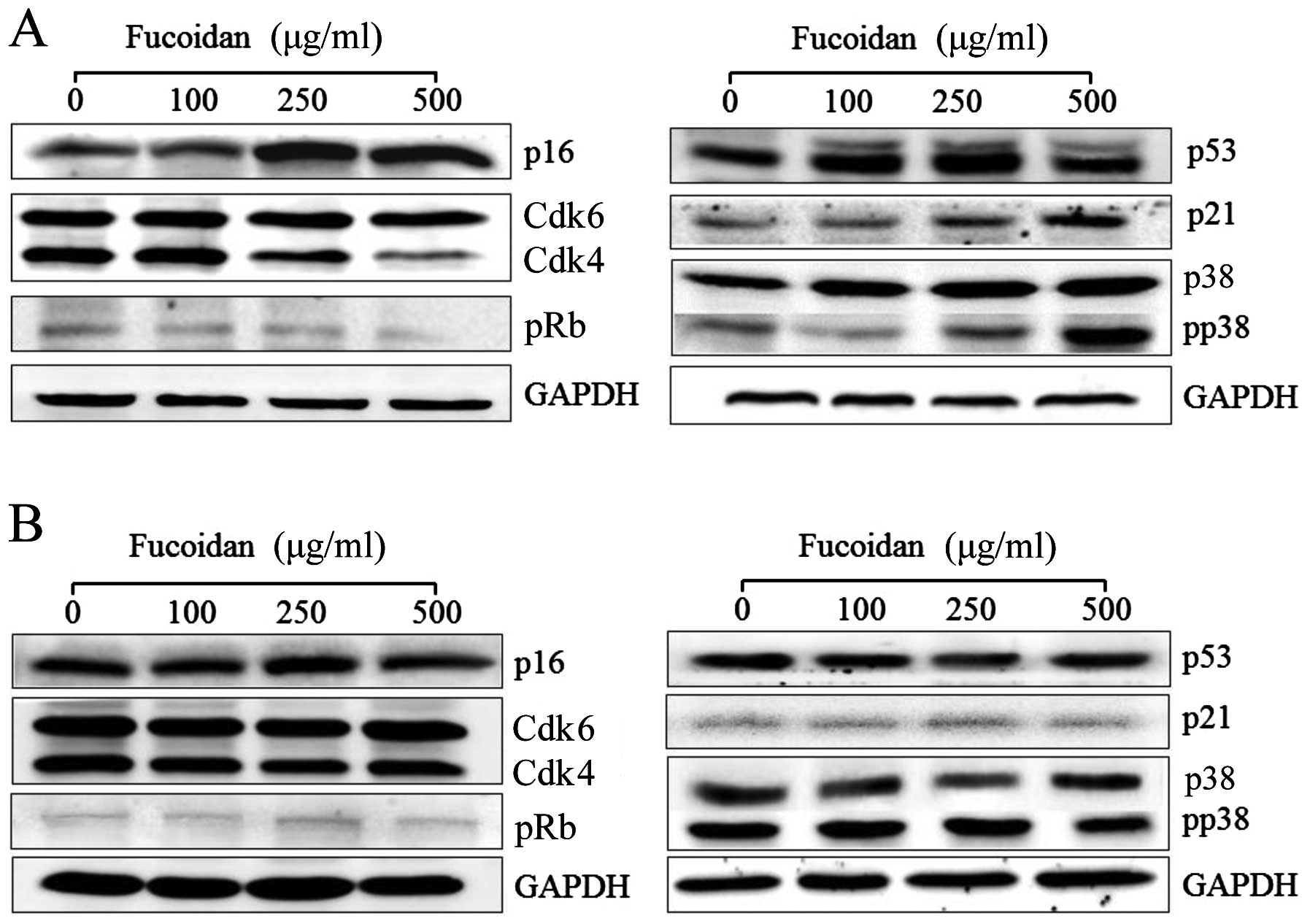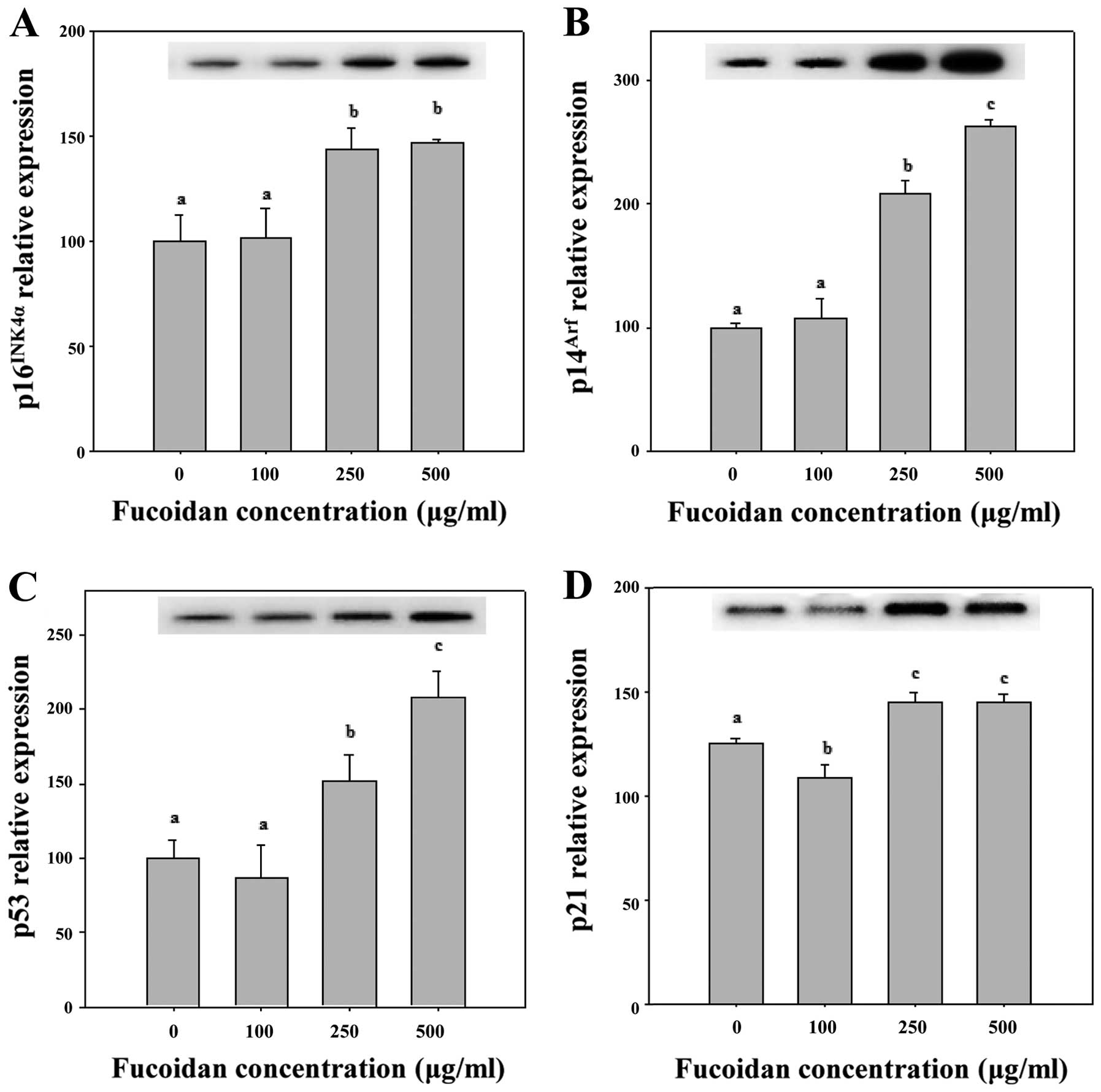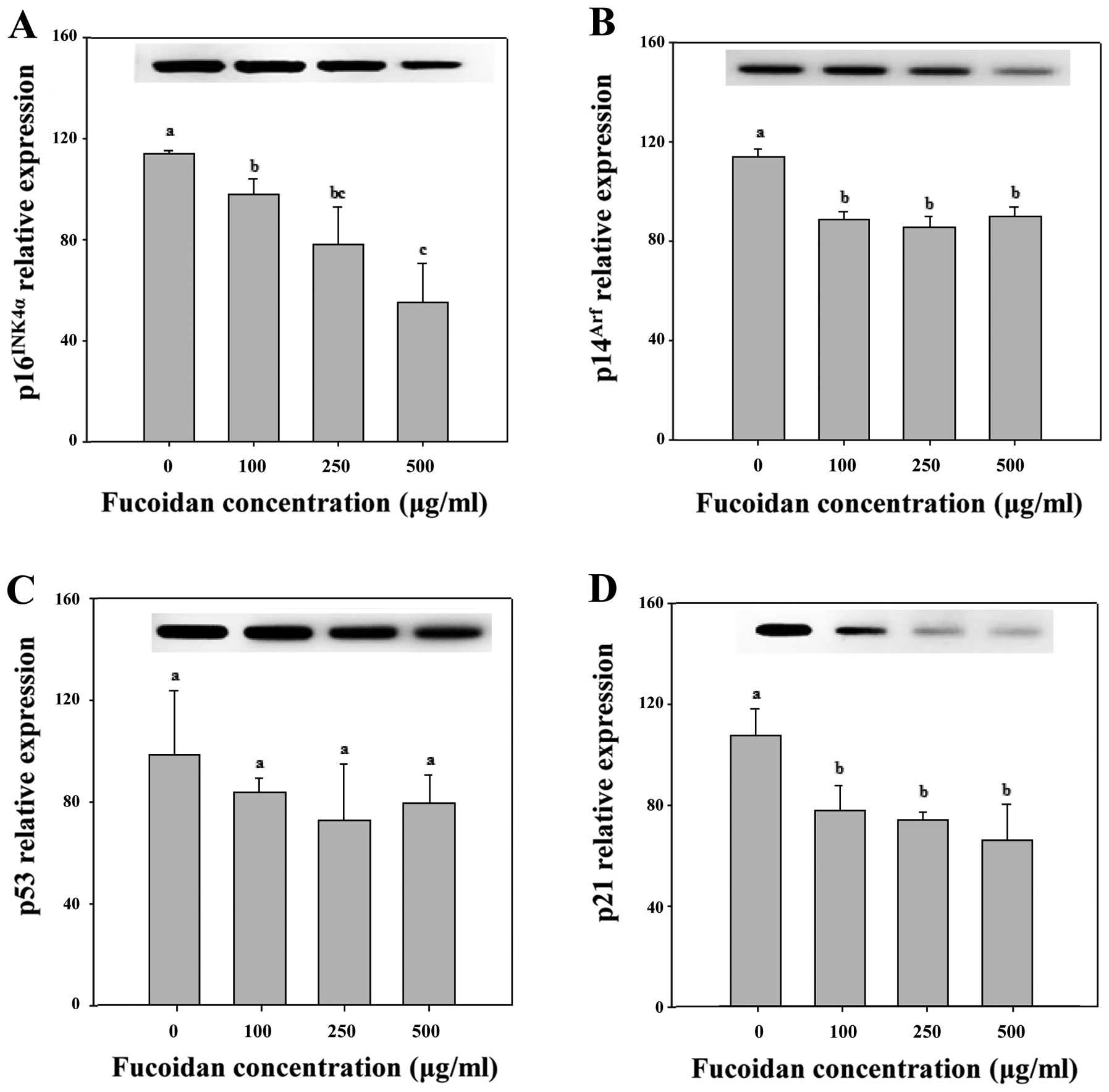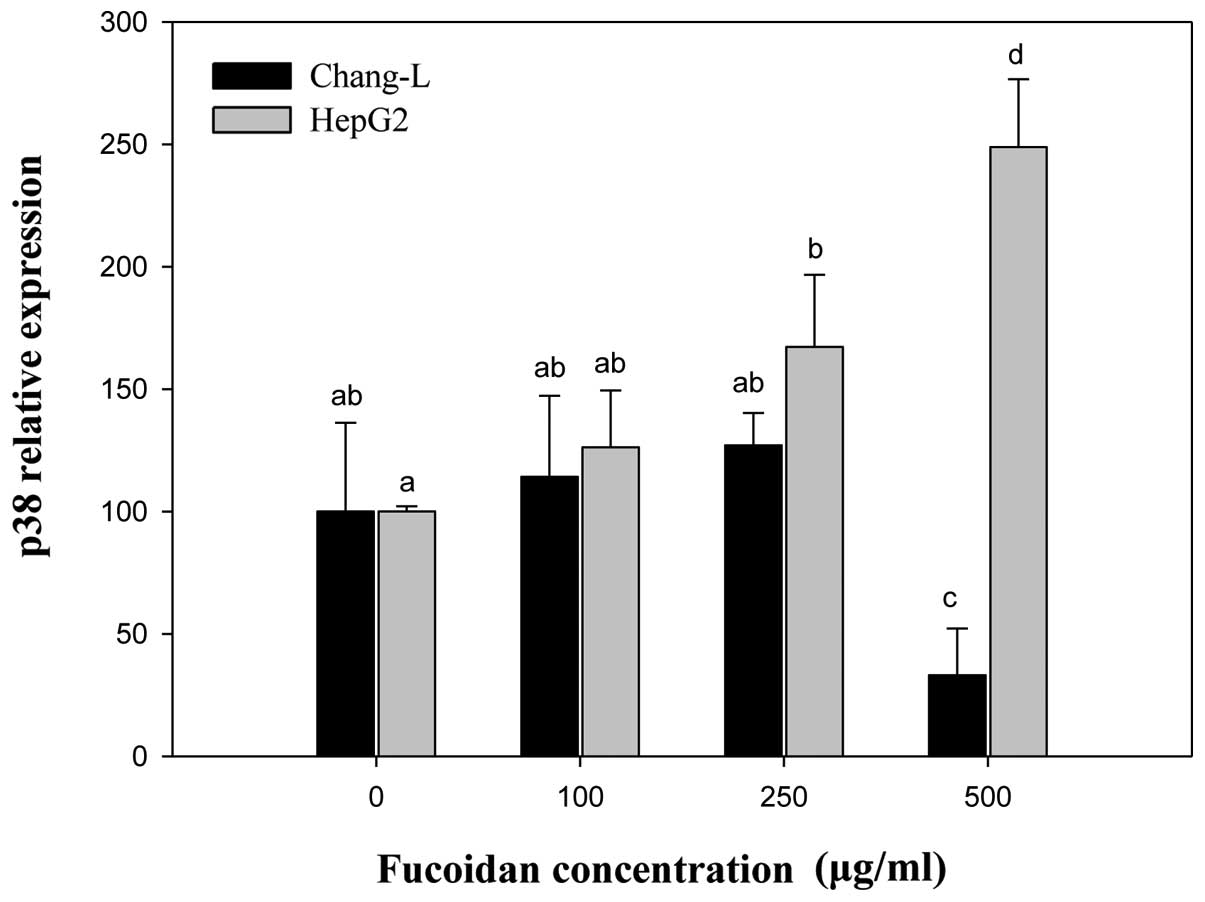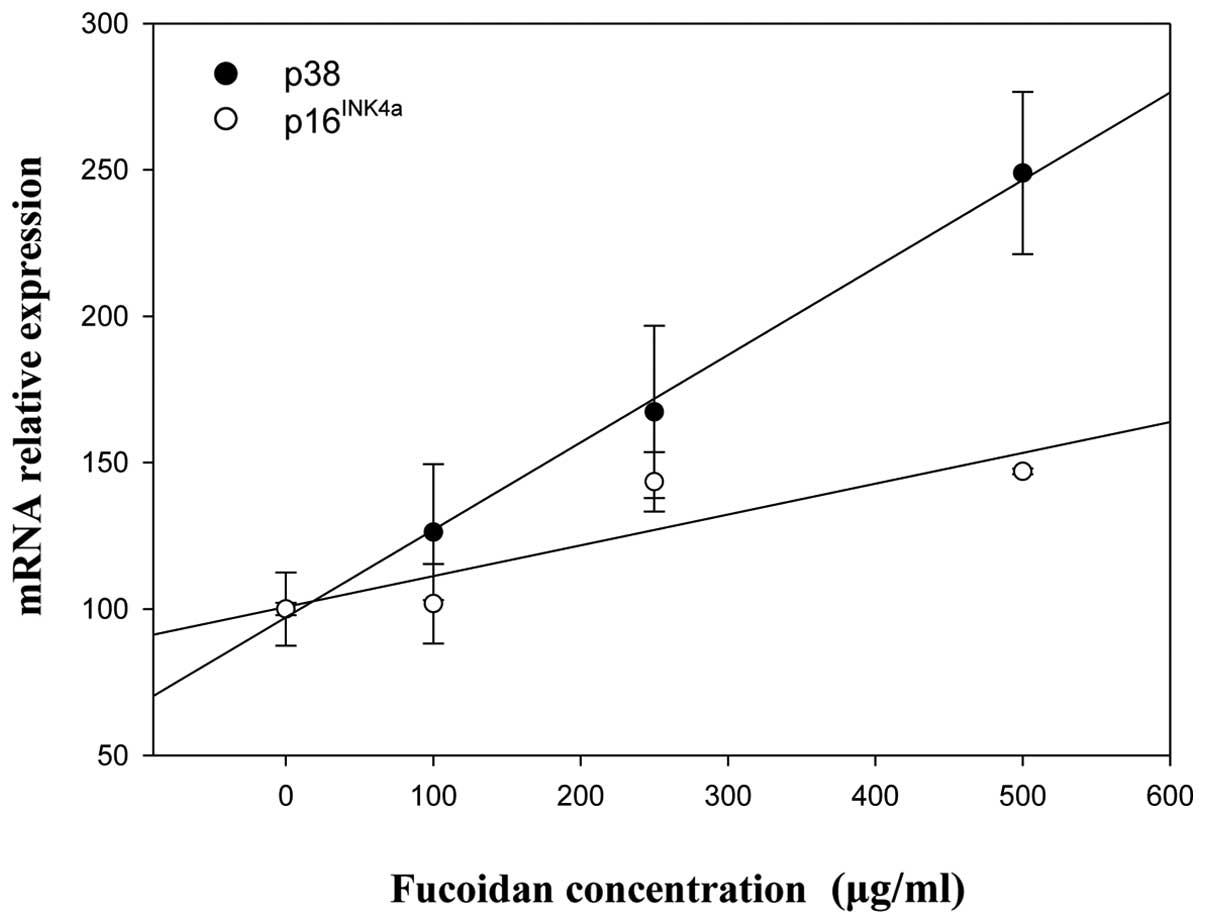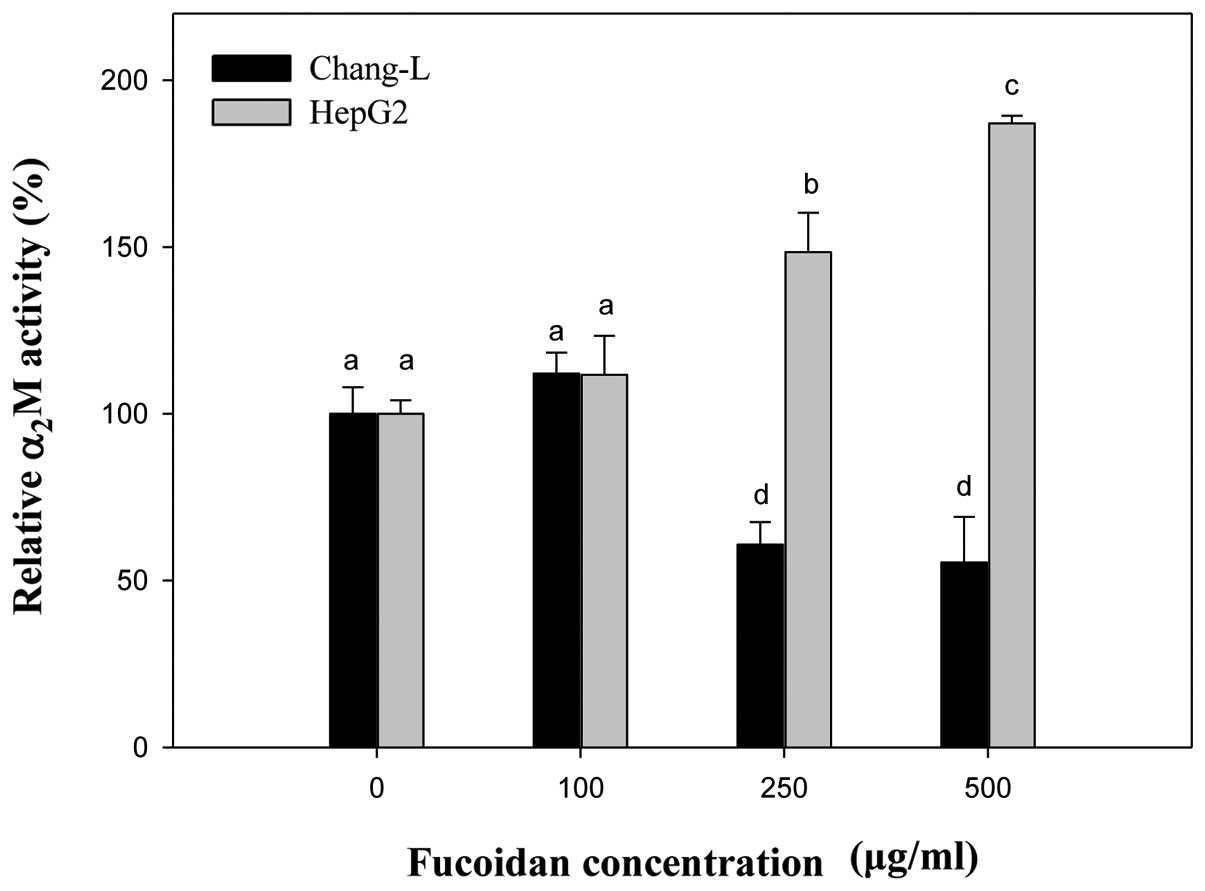|
1.
|
Li Y, Nichols MA, Shay JW and Xiong Y:
Transcriptional repression of the D-type cyclin-dependent kinase
inhibitor p16 by the retinoblastoma susceptibility gene product
pRb. Cancer Res. 54:6078–6082. 1994.PubMed/NCBI
|
|
2.
|
Dürig J, Vruhn T, Zurborn KH, Gutensohn K,
Bruhn HD and Bèress L: Anticoagulant fucoidan fractions from
Fucus vesiculosus induce platelet activation in
vitro. Thromb Res. 85:479–491. 1997.PubMed/NCBI
|
|
3.
|
Maruyama H, Tamauchi H, Hasimoto M and
Nakano T: Antitumor activity and immune response of Mekabu fucoidan
extracted from Sporophyll of Undaria pinnatifida. In vivo.
17:245–249. 2003.PubMed/NCBI
|
|
4.
|
Wang J, Zhang Q, Zang Z and Li Z:
Antioxidant activity of sulfated polysaccharide fractions extracted
from Laminaria japonica. Int J Biol Macromol. 42:127–132.
2008. View Article : Google Scholar : PubMed/NCBI
|
|
5.
|
Hu T, Liu D, Chen Y, Wu J and Wang S:
Antioxidant activity of sulfated polysaccharide fractions extracted
from Undaria pinnitafida in vitro. Int J Biol Macromol.
46:193–198. 2010. View Article : Google Scholar : PubMed/NCBI
|
|
6.
|
Lee H, Kim JS and Kim E: Fucoidan form
seaweed Fucus vesiculosus inhibits migration and invasion of
human lung cancer cells via PI3K-Akt-mTOR pathways. PLoS One.
7:e506242012.PubMed/NCBI
|
|
7.
|
Xue M, Ge Y, Zhang J, et al: Anticancer
properties and mechanisms of fucoidan on mouse breast cancer in
vitro and in vivo. PLoS One. 7:e434832012. View Article : Google Scholar : PubMed/NCBI
|
|
8.
|
Kim NY, Sun JM, Kim YJ, et al:
Cisplatin-based combination chemotherapy for advanced
hepatocellular carcinoma: a single centre experience before the
sorafenib era. Cancer Res Treat. 42:203–209. 2010. View Article : Google Scholar : PubMed/NCBI
|
|
9.
|
Rayess H, Wang MB and Srivatsan ES:
Cellular senescence and tumor suppressor gene p16. Int J Cancer.
130:1715–1725. 2012. View Article : Google Scholar : PubMed/NCBI
|
|
10.
|
Krishnamurthy J, Torrice C, Ramsey MR, et
al: Ink4a/Arf expression is a biomarker of aging. J Clin Invest.
114:1299–1307. 2004. View Article : Google Scholar : PubMed/NCBI
|
|
11.
|
Stein GH, Drullinger LF, Soulard A and
Dulić V: Differential roles for cyclin-dependent kinase inhibitors
p21 and p16 in the mechanisms of senescence and differentiation in
human fibro-blasts. Mol Cell Biol. 19:2109–2117. 1999.PubMed/NCBI
|
|
12.
|
Li B, Lu F, Wei X and Zhao R: Fucoidan:
structure and bioactivity. Molecules. 13:1671–1695. 2008.
View Article : Google Scholar : PubMed/NCBI
|
|
13.
|
Hara E, Smith R, Parry D, Tahara H, Stone
S and Peters G: Regulation of p16CDKN2 expression and its
implications for cell immortalization and senescence. Mol Cell
Biol. 16:859–867. 2008.PubMed/NCBI
|
|
14.
|
Haber DA: Splicing into senescence: the
curious case of p16 and p19Arf. Cell. 91:555–558. 1997.
View Article : Google Scholar : PubMed/NCBI
|
|
15.
|
Pomerantz J, Schreiber-Agus N, Liégeois
NJ, et al: Ink4a tumor suppressor gene product, p19Arf,
interacts with MDM2 and neutralizes MDM2’s inhibition of p53. Cell.
92:713–723. 1998. View Article : Google Scholar : PubMed/NCBI
|
|
16.
|
Dimri GP, Itahana K, Acosta M and Campisi
J: Regulation of a senescence checkpoint response by the E2F1
transcription factor and p14Arftumor suppressor. Mol
Cell Biol. 20:273–285. 2000. View Article : Google Scholar : PubMed/NCBI
|
|
17.
|
Sharpless NE: INK4a/ARF: A multifunctional
tumor suppressor locus. Mutat Res. 576:22–38. 2005. View Article : Google Scholar : PubMed/NCBI
|
|
18.
|
Han J and Sun P: 2007. The pathways to
tumor suppression via route p38. Trends Biochem Sci. 32:364–371.
2007. View Article : Google Scholar : PubMed/NCBI
|
|
19.
|
Bulavin DV and Fornace AJ Jr: p38 MAPK
kinase’s emerging role as a tumor suppressor. Adv Cancer Res.
92:95–118. 2004.
|
|
20.
|
Serrano M, Lin AW, McCurrach ME, Beach D
and Lowe SW: Oncogenic ras provokes premature cell senescence
associated with accumulation of p53 and p16INK4a. Cell.
88:593–602. 1997. View Article : Google Scholar : PubMed/NCBI
|
|
21.
|
Ma H, Li R, Zhang Z and Tong T: mRNA level
of alpha-2-macro-globulin as an aging biomarker of human
fibroblasts in culture. Exp Gerontol. 39:415–421. 2004. View Article : Google Scholar : PubMed/NCBI
|
|
22.
|
Serrano M: The INK4a/ARF locus in murine
tumorigenesis. Carcinogenesis. 21:865–869. 2000. View Article : Google Scholar : PubMed/NCBI
|
|
23.
|
Schmitt CA, Fridman JS, Yang M, et al: A
senescence program controlled by p53 and
p16INK4acontributes to the outcome of cancer therapy.
Cell. 109:335–346. 2002. View Article : Google Scholar : PubMed/NCBI
|
|
24.
|
Schumacher M, Kelkel M, Dicato M and
Diederich M: Gold from the sea: marine compounds as inhibitors of
the hallmarks of cancer. Biotechnol Adv. 29:531–547. 2011.
View Article : Google Scholar : PubMed/NCBI
|
|
25.
|
Ishii H, Iwatsuki M, Ieta K, et al: Cancer
stem cells and chemoradiation resistance. Cancer Sci. 99:1871–1877.
2008. View Article : Google Scholar
|
|
26.
|
Alekseyenko TV, Zhanayeva SY, Venediktova
AA, et al: Antitumor and antimetastatic activity of fucoidan, a
sulfated polysaccharide isolated from the Okhotsk Sea Fucus
evanescens brown alga. Bull Exp Biol Med. 143:730–732. 2007.
View Article : Google Scholar : PubMed/NCBI
|
|
27.
|
Meek DW: 2009. Tumour suppression by p53:
a role for the DNA damage response? . Nat Rev Cancer. 9:714–723.
2009.PubMed/NCBI
|
|
28.
|
Ressler S, Bartkova J, Niederegger H, et
al: p16INK4ais a robust in vivo biomarker of cellular
aging in human skin. Aging Cell. 5:379–389. 2006.
|
|
29.
|
Melzer D: Genetic polymorphisms and human
aging: association studies deliver. Rejuvenation Res. 11:523–526.
2008. View Article : Google Scholar : PubMed/NCBI
|
|
30.
|
Fedorov SN, Shubina LK, Bode AM, Stonik VA
and Dong Z: Dactylone inhibits epidermal growth factor-induced
transformation and phenotype expression of human cancer cells and
induces G1-S arrest and apoptosis. Cancer Res. 67:5914–5920. 2007.
View Article : Google Scholar
|
|
31.
|
Park C, Kim GY, Kim GD, et al: Suppression
of U937 human monocytic leukemia cell growth by dideoxypetrosynol
A, a polyacetylene from the sponge Petrosia sp., via induction of
Cdk inhibitor p16 and down-regulation of pRB phosphorylation. Oncol
Rep. 16:171–176. 2006.PubMed/NCBI
|
|
32.
|
Müller M, Strand S, Hug H, et al:
Drug-induced apoptosis in hepatoma cells is mediated by the CD95
(APO-1/Fas) receptor/ligand system and involves activation of
wild-type p53. J Clin Invest. 99:403–413. 1997.PubMed/NCBI
|
|
33.
|
Vogelstein B, Lane D and Levine AJ:
Surfing the p53 network. Nature. 408:307–310. 2000. View Article : Google Scholar : PubMed/NCBI
|
|
34.
|
Fujii H, Honoki K, Tsujiuchi T, et al:
Reduced expression of INK4a/ARF genes in stem-like sphere cells
from rat sarcomas. Biochem Biophysic Res Commun. 362:773–778. 2007.
View Article : Google Scholar : PubMed/NCBI
|
|
35.
|
Deng J, Qian Y, Geng L, et al: Involvement
of p38 mitogen-activated protein kinase pathway in honokiol-induced
apoptosis in a human hepatoma cell line (HepG2). Liver Int.
28:1458–1464. 2008. View Article : Google Scholar
|
|
36.
|
Wang YX, Xu XY, Su WL, et al: Activation
and clinical significance of p38 MAPK signaling pathway in patients
with severe trauma. J Surg Res. 161:119–125. 2009. View Article : Google Scholar : PubMed/NCBI
|
|
37.
|
Hyun JH, Kim SC, Kang JI, et al: Apoptosis
inducing activity of fucoidan in HCT-15 colon carcinoma cells. Biol
Pharm Bull. 32:1760–1764. 2009. View Article : Google Scholar : PubMed/NCBI
|
|
38.
|
Iyoda K, Sasaki Y, Horimoto M, et al:
Involvement of the p38 mitogen-activated protein kinase cascade in
hepatocellular carcinoma. Cancer. 97:3017–3026. 2003. View Article : Google Scholar : PubMed/NCBI
|
|
39.
|
Wagner EF and Nebreda AR: Signal
integration by JNK and p38 MAPK pathways in cancer development. Nat
Rev Cancer. 9:537–549. 2009. View Article : Google Scholar : PubMed/NCBI
|
|
40.
|
Schyschka L, Rudy A, Jeremias I, Barth N,
Pettit GR and Vollmar AM: Spongistatin 1: a new chemosensitizing
marine compound that degrades XIAP. Leukemia. 22:1737–1745. 2008.
View Article : Google Scholar : PubMed/NCBI
|
|
41.
|
Igney FH and Krammer PH: Death and
anti-death: tumor resistance to apoptosis. Nat Rev Cancer.
2:277–288. 2002. View
Article : Google Scholar : PubMed/NCBI
|
|
42.
|
Verzola D, Gandolfo MT, Gaetani G, et al:
Accelerated senescence in the kidneys of patients with type 2
diabetic nephropathy. Am J Physiol Renal Physiol. 295:F1563–F1573.
2008. View Article : Google Scholar : PubMed/NCBI
|
|
43.
|
Tsygankow D, Liu Y, Sanoff HK, Sharpless
NE and Elston TC: A quantitative model for age-dependent expression
of the p16INK4atumor suppressor. Proc Natl Acad Sci USA.
106:16562–16567. 2009. View Article : Google Scholar : PubMed/NCBI
|
|
44.
|
Huschtscha LI and Reddel RR:
p16INK4aand the control of cellular proliferative life
span. Carcinogenesis. 20:921–926. 1999.
|
|
45.
|
Duan J, Zhang Z and Tong T: Senescence
delay of human diploid fibroblast induced by anti-sense
p16INK4aexpression. J Biol Chem. 276:48325–48331.
2001.PubMed/NCBI
|
|
46.
|
Carnero A, Hudson JD, Price CM and Beach
DH: p16INK4Aand p19ARF act in overlapping pathways in
cellular immortalization. Nat Cell Biol. 2:148–155. 2000.
|
|
47.
|
Jung YS, Qian Y and Chen X: Examination of
the expanding pathway for the regulation of p21 expression and
activity. Cell Signal. 22:1003–1012. 2010. View Article : Google Scholar : PubMed/NCBI
|
|
48.
|
Collado M, Blasco MA and Serrano M:
Cellular senescence in cancer and aging. Cell. 130:223–233. 2007.
View Article : Google Scholar : PubMed/NCBI
|
|
49.
|
Tahara H, Sato E, Noda A and Ide T:
Increase in the expression level of
p21sdi1/cip1/waf1 with increasing division age
in both normal and SV40-transformed human fibroblasts. Oncogene.
10:835–840. 1995.
|
|
50.
|
Kondo T, Sakaguchi M and Namba M:
Two-dimensional gel electrophoresis studies on the cellular aging:
accumulation of alpha-2-macroglobulin in human fibroblasts with
aging. Exp Gerontol. 36:487–495. 2001. View Article : Google Scholar : PubMed/NCBI
|















